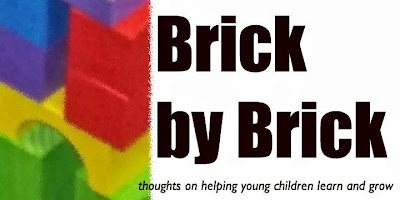 In my last post, I wrote about context. Learning must connect to kids and their lives.
In my last post, I wrote about context. Learning must connect to kids and their lives.I recently read the blog post How Not to Learn to Write (An Everyday Story). In that post she writes "And when we keep reading and writing firmly planted in meaningful context, allowing our children to create words and read words naturally, they start to discover for themselves the joy of putting their thoughts to paper."
In our test-and-standards-obsessed world, we drill kids on letters and words and writing to connect to text. But we definitely (especially in the early years) need to create an atmosphere of writing. How do we do that?
Provide authentic situations for writing; give real reasons for kids to write.
When I put out telephones to use, I always add notepads and pencils. Kids have an opportunity to "take messages" or write down notes. When we use the digital scale, I add pencils and paper for kids to write down their observations.
In my second grade class last year, we observed caterpillars transforming into butterflies. We read lots of books about butterflies (and other life cycles). We drew pictures and wrote words about our observations - several times.
But I think the most important lesson I've learned about writing (and reading) with young kids - give them some choice and control.
We wrote a lot last year, reflecting on what we read as a class. My kids would always ask: "How many sentences? How much do I have to write?" This bothered me. I talked with the instructional coach at my school. After much discussion about why or what may be going on, we decided to include free journaling in the last month of school. (I used journals in my first grade class but had not used them much in this class.) So, at an appointed time in the day, we would get out the journals and write. About whatever they wanted. As much or as little as they wanted. I would write a comment back in the journal that they read the next day. The writing of my students changed so much. Some wrote only a sentence or two. Some wrote a page full (and added to the same writing the next day). But the complexity of sentences, the ideas expressed, the enthusiasm for writing CHANGED.
We do the same thing with our writing center in my church kindergarten class. Kids choose what to write. They choose the topic and the length. I may add some suggested prompts or pictures or ideas. But they choose what to do.
Kids can't always choose what to do or control the expectations. But including choice and control as much as possible helps kids connect with their writing. With all their learning.
How have you seen kids grow in their writing or learning through choice and control?
Provide authentic situations for writing; give real reasons for kids to write.
When I put out telephones to use, I always add notepads and pencils. Kids have an opportunity to "take messages" or write down notes. When we use the digital scale, I add pencils and paper for kids to write down their observations.
In my second grade class last year, we observed caterpillars transforming into butterflies. We read lots of books about butterflies (and other life cycles). We drew pictures and wrote words about our observations - several times.
But I think the most important lesson I've learned about writing (and reading) with young kids - give them some choice and control.
We wrote a lot last year, reflecting on what we read as a class. My kids would always ask: "How many sentences? How much do I have to write?" This bothered me. I talked with the instructional coach at my school. After much discussion about why or what may be going on, we decided to include free journaling in the last month of school. (I used journals in my first grade class but had not used them much in this class.) So, at an appointed time in the day, we would get out the journals and write. About whatever they wanted. As much or as little as they wanted. I would write a comment back in the journal that they read the next day. The writing of my students changed so much. Some wrote only a sentence or two. Some wrote a page full (and added to the same writing the next day). But the complexity of sentences, the ideas expressed, the enthusiasm for writing CHANGED.
We do the same thing with our writing center in my church kindergarten class. Kids choose what to write. They choose the topic and the length. I may add some suggested prompts or pictures or ideas. But they choose what to do.
Kids can't always choose what to do or control the expectations. But including choice and control as much as possible helps kids connect with their writing. With all their learning.
How have you seen kids grow in their writing or learning through choice and control?









